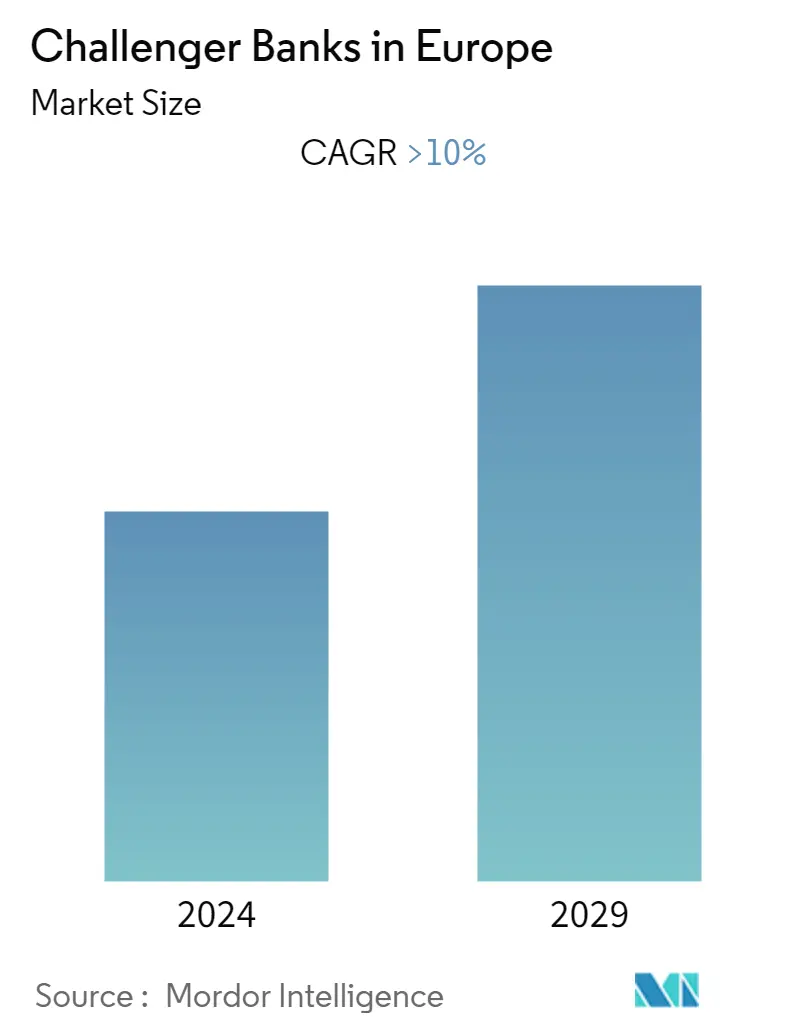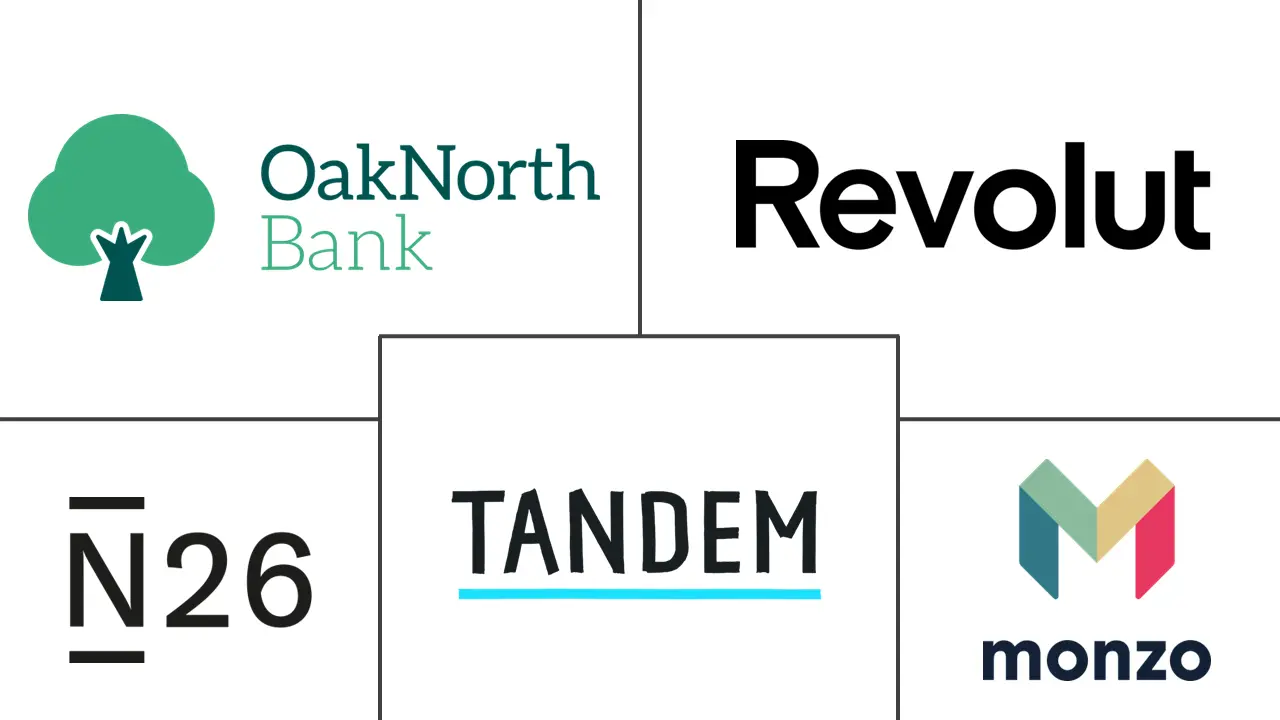Market Size of Challenger Banks in Europe

| Study Period | 2020 - 2029 |
| Base Year For Estimation | 2023 |
| Forecast Data Period | 2024 - 2029 |
| Historical Data Period | 2020 - 2022 |
| CAGR | 10.00 % |
| Market Concentration | Medium |
Major Players
*Disclaimer: Major Players sorted in no particular order |
European Challenger Banks Market Analysis
The Challenger Banks Market is poised to grow at a CAGR of 10% during the forecast period. The Europe Banking Industry is similar to the US banking landscape. The Europe banking sector is dominated by large players. However, it also showcases characteristics of a market ripe for disruption through a combination of economic, regulatory & secular trends. Following the crisis, large institutions damaged their reputations and created an environment for disruptors that are supported by innovative technology and can offer competitive banking and lending services. Covid-19 had a negative impact on challenger banks. The use of challenger banks fell by around 90%. However, the pandemic has forced more people than ever to start using digital banking applications. This strengthens the future of tech-oriented challenger banks.
The origins of Challenger Banks in the UK date back to the most recent crisis, during which large institutions engaged in questionable practices and undertook risks through complex business activities, difficult to comprehend for both regulators and consumers. UK has also led the charge across EU FinTech, as it is home to the most extensive network of established Challenger Banks in Europe. The UK has one of the most established and concentrated banking industries in Europe, with large financial institutions controlling significant market share and the market is supported by traditionally high regulatory barriers to entry.
European Challenger Banks Industry Segmentation
An understanding of the Challenger Banks in Europe, regulatory environment, challengers banks, and their business models, along with detailed market segmentation, product offerings such as deposits, loans to define their financial performance indicators, current market trends, changes in market dynamics, and growth opportunities. In-depth analysis of the market size and forecast for the various segments. The Challenger Banks Market in Europe is segmented By services offered (Payments, Savings Products, Current Account, Consumers Credits, Loans and Others), By end-user type (Business Segment and Personal Segment) and By Geography (UK, Germany, France, Italy, Spain, Netherlands, and Rest of Europe). The report offers market size and forecasts for Challenger Banks in Europe Market in value (USD Million) for all the above segments.
| By Service Type | |
| Payments | |
| Savings Products | |
| Current Account | |
| Consumer Credit | |
| Loans | |
| Others |
| By End-User Type | |
| Business Segment | |
| Personal Segment |
| By Country | |
| UK | |
| Germany | |
| France | |
| Italy | |
| Spain | |
| Netherlands | |
| Rest Of Europe |
Challenger Banks in Europe Size Summary
The Challenger Banks Market in Europe is experiencing significant growth, driven by the need for disruption in a banking sector traditionally dominated by large institutions. The European banking landscape, akin to that of the US, is characterized by substantial market share held by major players. However, the aftermath of the financial crisis and the subsequent reputational damage to these institutions have paved the way for challenger banks, which leverage innovative technology to offer competitive banking and lending services. Despite the initial setback during the Covid-19 pandemic, which saw a drastic decline in the use of challenger banks, the shift towards digital banking has reinforced the potential for tech-oriented disruptors to thrive. The UK, a leader in the European FinTech space, has been at the forefront of this movement, with a robust network of challenger banks benefiting from regulatory changes like the overhaul of the Payments Services Directive, which has allowed them to expand their service offerings and customer base.
Challenger banks in Europe are capitalizing on the opportunity to provide superior products at lower costs, appealing to consumers disenchanted with the legacy systems of traditional banks. By utilizing online platforms and attracting funding, these banks offer more attractive interest rates for savings accounts compared to their larger counterparts. The market is marked by the presence of key players such as OakNorth Bank, Revolut, Number26 GmBH, Monzo, and Tandem Bank, who are actively expanding their offerings and customer reach. Notable developments include OakNorth Bank's acquisition of a stake in property lender ASK Partners and Revolut's substantial funding round to enhance its financial services. These strategic moves underscore the dynamic nature of the challenger banks market in Europe, which continues to grow and evolve in response to technological advancements and changing consumer preferences.
Challenger Banks in Europe Market Size - Table of Contents
-
1. MARKET INSIGHTS AND DYNAMICS
-
1.1 Market Overview
-
1.2 Market Drivers
-
1.3 Market Restraints
-
1.4 Porters 5 Force Analysis
-
1.4.1 Threat of New Entrants
-
1.4.2 Bargaining Power of Buyers/Consumers
-
1.4.3 Bargaining Power of Suppliers
-
1.4.4 Threat of Substitute Products
-
1.4.5 Intensity of Competitive Rivalry
-
-
1.5 Impact of COVID-19 on the Market
-
-
2. MARKET SEGMENTATION
-
2.1 By Service Type
-
2.1.1 Payments
-
2.1.2 Savings Products
-
2.1.3 Current Account
-
2.1.4 Consumer Credit
-
2.1.5 Loans
-
2.1.6 Others
-
-
2.2 By End-User Type
-
2.2.1 Business Segment
-
2.2.2 Personal Segment
-
-
2.3 By Country
-
2.3.1 UK
-
2.3.2 Germany
-
2.3.3 France
-
2.3.4 Italy
-
2.3.5 Spain
-
2.3.6 Netherlands
-
2.3.7 Rest Of Europe
-
-
Challenger Banks in Europe Market Size FAQs
What is the current Challenger Banks in Europe Market size?
The Challenger Banks in Europe Market is projected to register a CAGR of greater than 10% during the forecast period (2024-2029)
Who are the key players in Challenger Banks in Europe Market?
OakNorth Bank, Revolut, Number26 GmBH, Monzo and Tandem Bank are the major companies operating in the Challenger Banks in Europe Market.

